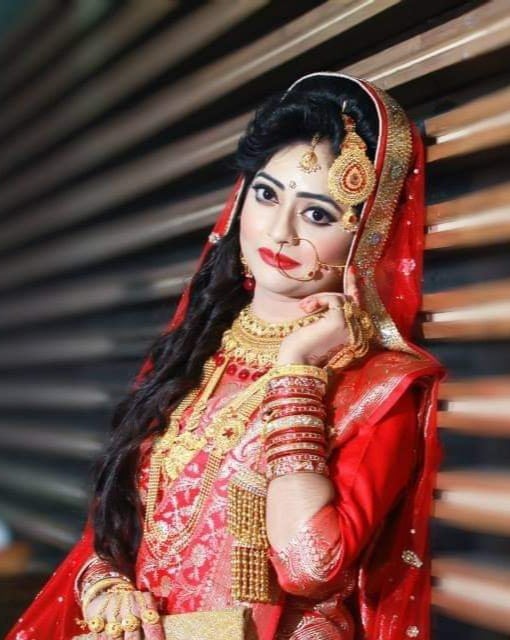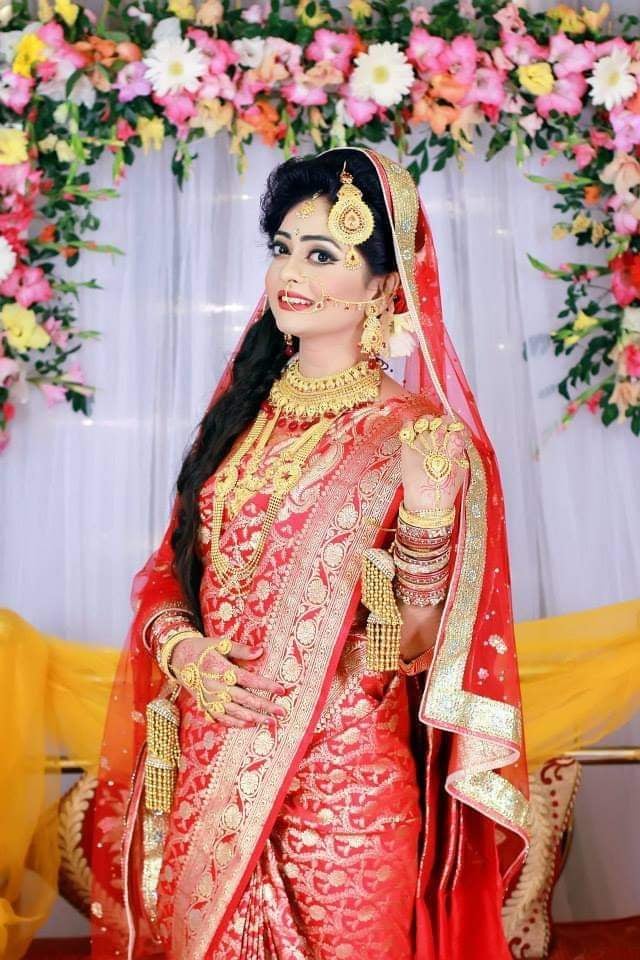A Sudden Discomfort
Rupa has a number of things to do today. She has to visit a number of shopping centres and find the most beautiful and elegant jewellery that she can find for her friend, Mita. While recommending the jewellery, she has to be careful about the price as well, as Mita does not want to pay for anything too expensive.
Mita is Rupa’s best friend. She has been studying for her Master’s degree in Sweden. She has already completed her course and she is now looking forward to getting married in two weeks’ time, just after her graduation ceremony.
Rupa wanted to start shopping in the very early morning. However, it is not possible in Dhaka, as they open the shops after ten a.m. and it takes another thirty to forty minutes before the day’s business is “in full swing”.
Rupa has started with Plaza AR, the nearest shopping centre to her house, because her earlier experience tells her that sometimes exceptional stuff can be found in places very near to where she lives. There is another reason for choosing Plaza AR as the first place to explore. The reason is that there is an ATM there from which Rupa can withdraw cash. Mita will send the amount to Rupa’s account after the shopping is done.
Rupa has prepared a list for today’s shopping. She believes this list will help her not to spend too much, as she has a tendency to buy unnecessary things. That is why, nowadays, she is very cautious. She has promised herself not to buy anything before asking herself whether she really needs it or not.
For today’s shopping she has decided to stop at some special shops that she knows of, which sell very fine jewellery. This is how she wants to use her earlier experience of window shopping. After all, she believes every earlier experience can be useful. She came across this idea at a recent talk she heard, in which the speaker explained how his listeners could be more productive and careful learners if they used their background knowledge and experience when learning.
In Plaza AR, Rupa spends only a few minutes and finds three beautiful jhaptas for Mita’s hair, one of which she loves the most. With the permission of the shopkeepers she takes photographs of all three for Mita. Rupa knows Mita well, so she knows that Mita will also like the one she loves the most. Still, she will send all the photographs so that Mita might not feel that her special day was not given much attention.
Rupa’s next destination is the Metro Shopping Mall. Though she is getting hungry by now, and time is passing quickly, it is not so far to go. Here, she explores only two well-known shops and decides on the bangles, the kongkons, the jhumka, the shithipati and the noth. In Bangladesh, the noth, or nose pin, is supposed to be given by the groom. Elderly relatives pray for a long stay of the noth in the bride’s nose as a sign of their hope for the long life of the husband.

Photo courtesy of Lira Ahmed
The man whom Mita is going to marry is a very busy person. He works in the field of education, and she was introduced to him during her studies. He does not have any family member to shop for him. Fortunately, however, he has agreed to buy the wedding ring himself.
Now, all that Rupa has to do is choose the necklaces. She has to order two, a short one and a long one known as a shita har. She chooses two sets of these from Shimanto Square, one of her favorite shopping centres.
When she gets married, Mita is going to wear a red katan with golden kolka, so Rupa is trying to find jewellery that will match perfectly. What she chooses has a golden base and is made more attractive with white, golden and red stones. Rupa also chooses a milky-white pearl finish for the border for each piece.

Photo courtesy of Afrin Anis Rahman
The orders are still only at the first stage, because Mita can only agree after she sees all the photographs. After all, it is Mita who is the bride, so she will be the one who makes the choice in the end. Rupa is highly satisfied with all the things she has chosen. She is sure that her friends will support her efforts. However, she cannot help being bothered by one other thing right now. At this very moment, she suddenly finds that she is more worried about the noodles she has eaten on her way to Shimanto Square.
Because she was worried about being stuck in Dhaka’s crazy traffic, she bought “takeaway” food, a box of chicken-cheese noodles (that is what they called it), from an unknown café, and finished eating it while riding to Shimanto Square on a rickshaw. For some reason, she did not enjoy the taste at all. In fact, her earlier experience of eating takeaway food has not always had happy results. While she waits for Mita to approve all the orders, Rupa finds she is also anxiously waiting to see whether her stomach approves of her lunch…
_________________________________________________________________________
Learning Activities
Vocabulary Lists: Learn (or review, if you already know them) the words from the following list…
-
High Frequency Words from the 2nd 1000 General Service Word List
| anxiously | border | cheese | elderly | hungry | match | photograph | recommending | stuck | |
| approve | busy | chicken | explore | jewellery | nose | pin | satisfied | stuff | tendency |
| attention | cautious | during | forward | list | pearl | pray | shops/shopping | swing | worried |
| attractive | ceremony | education | hair | lunch | perfectly | quickly | stomach | taste |
2. Other Words. These words are not high frequency (or common) words. You will not meet them as often as the words from the two lists above. Check the meaning in the dictionary if you need to, to help you understand the story, but only learn these words if you already know all the words in the above lists well.
| bangles | cash | graduation | noodles | takeaway |
| bothered | crazy | groom | plaza / mall | traffic |
| bride | destination | metro | rickshaw | withdraw |
| café | elegant | necklace | shopkeeper | ATM (Automated Teller Machine) |
3. Idioms, phrasal verbs and collocations
Do you know the meaning of the underlined expressions in the phrases below?
“… the day’s business is in full swing.”
“… she bought takeaway food”
“… she cannot help being bothered by one other thing…”
4. Comprehension Questions
-
According to the story, who is the bride? Is she doing her own wedding shopping? Why/Why not?
-
Whom did the bride trust to do her wedding shopping? Why?
-
Why did Rupa send photographs of all three jhaptas to Mita?
-
What is the name of the groom referred in the story? How does the writer describe him?
-
What does a noth mean when it is used in a Bengali wedding?
5. Critical Thinking Questions
These questions require learners to use Higher Order Thinking Skills (HOTS) (The skills of analysing, applying, evaluating and creating are based on Bloom’s Revised Taxonomy of Cognitive Objectives. (See https://tlc.iitm.ac.in/PDF/Blooms%20Tax.pdf ). They are useful for small group or pair discussions, when you want learners to think more deeply about the ideas in the reading, and go beyond comprehension only. If time is limited, tell your learners to choose one or two of the questions they find most interesting, and discuss only those.
Alternatively, the questions could be used as ideas for writing. If you use these ideas as a writing task, make sure your learners have the chance to exchange their writing with each other and to talk about the opinions they have expressed. The exchange of ideas will enrich their understanding, expose them to a wider range of ideas, and build their explanation and persuasion skills.
-
Analyse: Compare the characters of Rupa, Mita and Mita’s soon-to-be husband. What kind of people do you think they are? (Think about how their concerns and interests might be similar or different before the wedding.)
-
Evaluate: Have you ever shopped for any of your friends or relatives who live abroad? How was that experience? Share.
-
Analyse: Do you think that wedding shopping is different from other kinds of shopping? If so, why and if not, why not?
-
Evaluate and Analyse: Is there any person of your acquaintance (not a family member) whom you could trust to do your wedding shopping? If so, explain the reasons why you would be comfortable giving responsibility to that person to shop for you on your special occasion.
-
Evaluate and Apply: What is the most important point of consideration for you when you shop? How important it is? If this is so important that it means you need to take a lot of time, money and energy, would you still try to address that? Why/Why not?
-
Evaluate and Create: In the story Rupa seems to have prepared a list and finishes the shopping one item at a time. How organized you think Rupa is? Have you considered your own future plans for your wedding shopping? What would you buy? If you have thought about this, share your plan step by step. If not, think about the probable steps and make a graphic organizer to show what your plan would look like. Use English, and share your plan with someone else. Explain what you plan to do, and say why you decided on each part of your plan.
-
Evaluate: What is ‘window shopping’? Do you have any experience of window shopping? Describe your window shopping experience. How helpful is window shopping for real shopping? Explain.
-
Evaluate: How frequently do you eat at an unknown cafe’? What makes one café better than another, in your opinion? Give as many reasons as possible.
-
Analyse: Why is the story named, “A Sudden Discomfort”? Explain.
-
Create and Evaluate: On a piece of paper, draw a bride wearing all the different kinds of jewellery mentioned in the story. Show your drawing to another person and in English explain everything you have drawn. Next, exchange your drawing with the person sitting beside you. Give your partner a score using the following scale.
0 = Did not do this; 1 = OK; 2 = Good; 3 = Very Good; 4 = Wonderful; 5 = 100% Excellent
| Your Partner’s Name: | 0 | 1 | 2 | 3 | 4 | 5 |
| Careful drawing | ||||||
| Creative ideas (speaking) | ||||||
| Clear explanation (easy to understand) | ||||||
| Clear explanation (easy to understand) | ||||||
| Completed all parts of the task* |
Total Score / 100
*All parts of the task =
-
drew a bride
-
drew all the pieces of jewellery described in the story
-
explained everything in the drawing
-
used English all the time while speaking. (You may use the Bangla words for the bride’s jewellery and clothing only.)